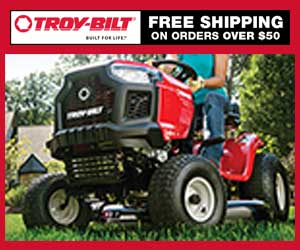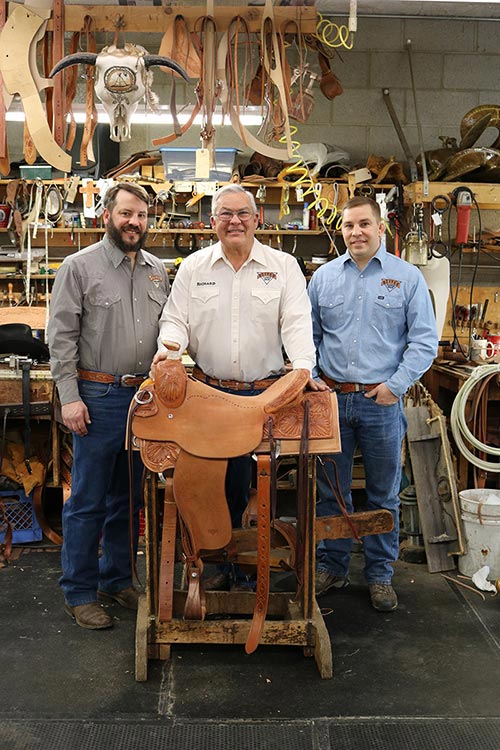
by Lynn Ascrizzi
Oliver Saddle Shop is the oldest, family-owned saddle maker in Texas.
In these modern times, you might think that the iconic, working cowboy is fast becoming a rare breed. But, longtime saddle maker Richard Oliver, who owns and operates the Oliver Saddle Shop in Amarillo, Texas, has his own take on the subject. He and his small team specialize in building saddles for the working cowboy.
“This is cow country, and there are a lot of cowboys. The population of working cowboys in our area is staying about the same. One of them may grow old and retire, but it seems like a new one is always replacing them,” he said. And, he tipped his wide-brimmed hat, figuratively speaking, to all the cowgirls who also put in a hard day’s work on the range.
He speculated that the romantic appeal of the cowboy life might also attract some newcomers. But as Oliver well knows, a real cowboy’s work is fraught with hardships, something he takes into consideration when building saddles.
“A lot of people don’t realize that a working cowboy leaves before daylight, rides all day, and gets home after dark. So, you don’t put them in a roping saddle. The roping saddle is an uncomfortable saddle to ride. Folks compete in those saddles in the arena. They’re flat seats — not made for riding long hours. You have to put him in a comfortable seat, so that all day long he can perform his duties. A lot of cowboys buy our equipment out of necessity, because they’re safer, more comfortable and better on the horse.”
He also knows that life in the wide-open spaces has its share of unexpected misfortune, like the multiple wildfires that erupted north of Amarillo and in the northeast Texas panhandle this past March, scorching nearly a half-million acres and taking ranches and farms, lives and livelihoods.
Yet, come hell or high water, every week, Oliver and the folks who work alongside him, build working saddles in a modest-sized saddle shop located on Plains Boulevard for the past 50 years. And, they’ve got plenty of orders. “We run anywhere from 10 to 12 months behind on saddle orders. We have used saddles in the front showroom, and as many new saddles as we can build along the way,” he said.
The shop also offers accessories, many on display in the front retail section, like chaps and chinks, handmade spurs, wallets, portfolios and ropes.

Last year, the fourth-generation family enterprise celebrated its 100th anniversary. The company was founded in 1917 by Richard Oliver’s grandfather, Claude William Oliver, in Vernon, Texas. Later, Claude was joined by his sons, Bill (Claude William Oliver, Jr.) and Jack. In 1960, Bill opened the Bill Oliver Saddle Shop in Amarillo. Then, his son, Richard, went to work with his dad. In turn, Richard was joined by his sons, Bryan and Zeb. All three are master saddle makers. They are now the Oliver Saddle Shop.
The small business has the distinction of being the oldest, family-owned saddle maker in Texas. It’s also one of only a handful of walk-in saddle shops in the nation. “We’re proud to make saddles for real cowboys,” Oliver, 68, said, something his dad and grandfather might have said, too.
The real cowboys, he explained, might be ranchers or ranch hands who have worked cattle for two or three generations. “Working saddles are not show pieces. They work with them on a daily basis. We still have cowboys who live in camps and on big ranches and look after several thousand acres and a lot of cattle. We also build saddles for horsemen, they want quality equipment too, just like cowboys use.”
Most cowboys own at least three or four saddles, he said. “They may have one horse that is round-backed and have a special saddle for that horse. Most of the horses they ride are ranch horses that can weigh 1,100 to 1,400 pounds — not the small, cutting horses.”
To Oliver, and all who work in his shop, the working cowboy is not a mythical figure, but a real person with everyday, nitty-gritty needs. They aim to give each customer the very best and to make a cowboy’s life a little easier.
“Most customers who come in to order or buy a saddle have been riding all their lives. They know what they want. We can fine-tune the saddle. If you buy a ready-made, you get what’s there. When you come in to see us, you can sit in that seat and we trim the seat until it fits. We have customers who are so particular, that when we’re putting the seat on the saddle, they’ll come by and sit in it until they get what they want,” he said.
MARK OF THE CRAFT
That early December morning, Oliver was working on custom-made headstalls for a customer’s Christmas gift. The pressure was on to get projects finished before the holiday. And, handcrafting saddles and leather accessories takes time.
“It may take a week to build a ‘plain saddle’; whereas, a factory might make 8 to 10 saddles per week,” he explained. “The basic difference between our working saddles and factory models is the quality of it — the way it’s built. We still have to hand stitch quite a bit and hand lace a lot of parts.”
Leather and saddletrees are purchased from U.S. companies. Their cowhide is ordered from Hermann Oak Leather in St. Louis, Missouri, and some lace and chap leather comes from Thiele Tanning Co. in Milwaukee, Wisconsin. They also work closely with Lewis Leather in Bryan, Texas, and buy kangaroo lace from Y~Knot in Kalispell, Montana.
The majority of sales come from walk-ins. “Our base price for a rough-side-out saddle is $4,500. An average price, right now, with all the tooling and custom-made hardware, is $5,500,” Oliver said. Other custom extras, such as more artisan-level tooling and a padded seat, can bring up the cost to $7,500 to $8,000.
About 80 saddles are sold annually, up from the past several years. “What is most popular with us is the rough-side-out saddle,” he said, referring to the rougher, flesh side of the cowhide. These saddles go through a lot in the brush, sun and all kinds of weather. If you scratch it — so what!”

“Half the saddles we build are ‘full rough out,’ ” his son, Bryan, added. “Some saddles we make are tooled or half-tooled. So, some might want the rough-side out and the rest made from the smoother side of the hide, with floral tooling.”
Since a saddle’s foundation is the saddletree, how each tree is crafted is critical. “We find the best saddletree makers. It’s our job to build the leather part, put the rigging on straight and build the saddle to where it’s comfortable all day,” Oliver said. Some of their most popular trees are Will James, Low Association, Tucson and Ranch Cutter.
“Tascosa is also popular,” Bryan said. “It’s named after a place that is now a ghost town. We build a lot of Buster Welches and Low Moose. There are a lot of tree makers out there. We work with the one that gives the best fit on the horse’s back and that doesn’t have problems with breakage. We take the order from the customer, call the tree maker, and he builds to the specs we give him.”
Roughly three out of four saddles that leave the shop are custom built. And, they also build and use their own saddles. Virtually, 100 percent of the saddles they make are for ranch use. About 50 percent are made for ranch owners, and the rest are for cowboys working cattle.
Just like work boots, working saddles get plenty of wear and tear. “Some of our cowboys, especially on the big ranches, figure a lifetime for a saddle is five to seven years, before they’ll need a major repair job. It may need new stirrup leather or a lining replaced underneath the skirts,” Oliver explained.
Repairs, however, make up only a small percentage of shop income. New saddles account for about 45 percent of sales, used saddles are about 5 percent, and chaps are about 5 percent. Remaining sales come from accessories, like headstalls, reins, breast collars, saddle pads, belts and the like.
The majority of sales are made from walk-ins and over the phone, 20 to 25 percent are made online. Saddle orders come from ranches in states like Texas, Oklahoma, Colorado and California, but a number of their products are shipped to Germany, Austria, France, England and Japan. “We’ve sold chaps to Japan,” he said.
A FAMILY COMMUNITY

His six, full-time leather workers include Oliver and his two sons, Bryan, 43, and Zeb, 40. Like their dad, they have grown up in the business. Altogether, a friendly, family-community atmosphere could be sensed in the positive comments and attitudes expressed by all who shared the workshop space.
“We’ve got nine of us working in here,” Oliver said of the 3,000-square-foot workshop and 1,800–square-foot front showroom area. “We’ve run out of room!” But, he’s not complaining. “God has put some really good people in the shop,” he reflected.
That day, Bryan had just finished a batch of belts and was aiming to complete a saddle. His favorite work is saddle building and leather tooling. “It’s home to me,” he said of the saddle shop, where by age 12, he was cleaning and repairing saddles. He built his first saddle the summer before his senior year in high school. He and his wife, Elisha Oliver, have two grown sons, Evan, 25, and Colton, 21, and 6-year-old daughter, June.
“I couldn’t sit at a desk. There’s days I wish I was outside, and days I’m glad I have an inside job,” he said. He enjoys the clientele — ranchers, cowboys and farmers. “When I go out to ranches, I see my products and that makes me feel proud. When I show people around the shop, they see that this is not an assembly line. Each craftsman builds a saddle from start to finish, one at a time,” he said.
Zeb had been making saddlebags and a medicine bag. “Saddles are the primary thing we make,” he said. He and his wife, Amy, have a son, Austin, 19, daughter, Faith, 15, and son, Andrew, 7. “Andrew spends quite a bit of time with us. I feel pretty fortunate to bring my children to work,” he said.
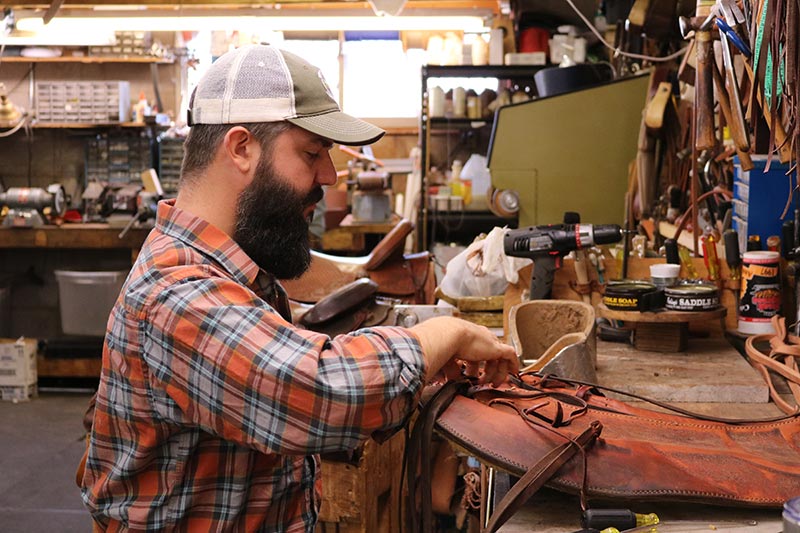
Colt Vernon, 31, is the only worker building saddles in the shop who is not an Oliver. He has been with the company for nine years. That day, he was building “a big, cowboy saddle with a traditional seat rigging. We build more for the working cowboy, not so much for the pro-rider,” he said. A graduate of West Texas A&M University, Colt has taken part in high school and college-level team roping competitions.
“What I enjoy most about working here is there’s lots to learn, and four generations have passed it down. Richard will tell you that he’s still learning, and he’s been doing it for 40 years, 40 hours per week! It’s a very good family to work for,” he said.
Full-time worker Andrew Cook, 32, has been with the shop for two years. A specialist in antique saddle restoration, he recently restored an early 1940’s saddle for the Panhandle-Plains Historical Museum in Canyon, Texas. He also makes strap goods and gift items, including occasional knife and gun scabbards and wallets.
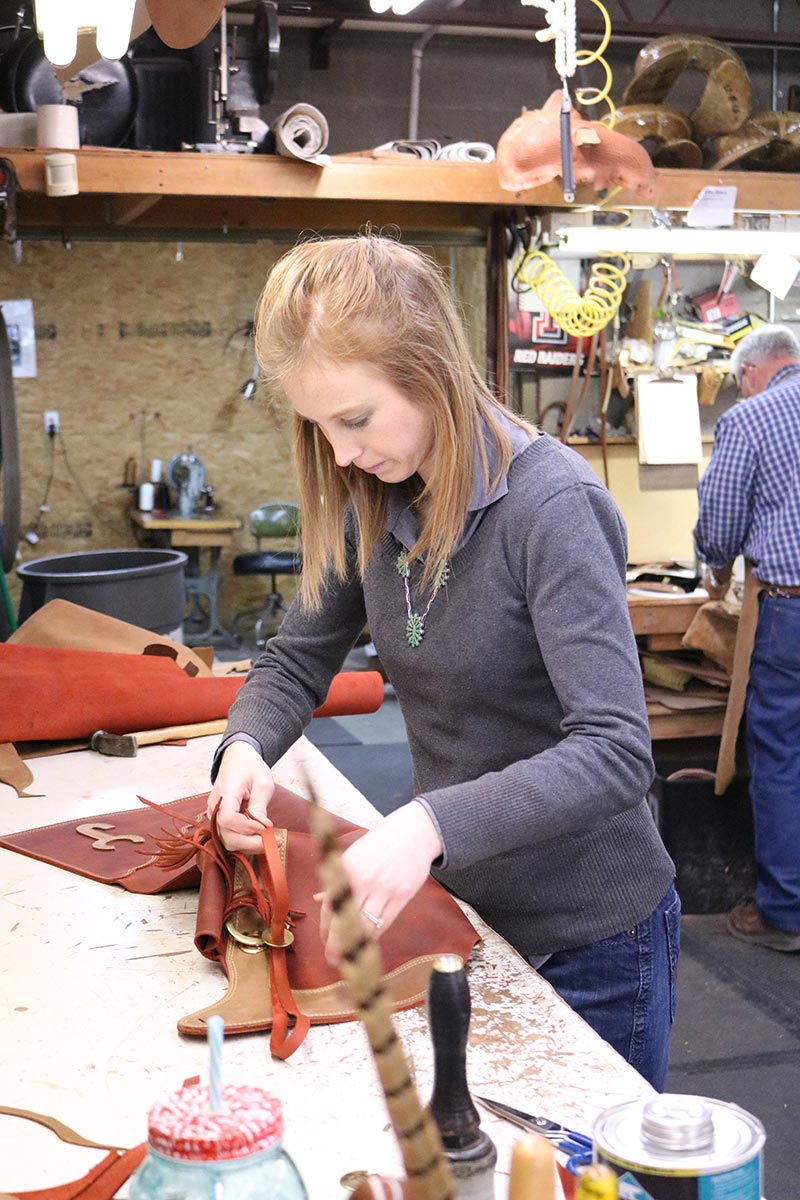
Hannah Mills, 28, also a graduate of WTAMU, makes sure products on the company website (www.oliversaddle.com) are up to date. She also handles the shop’s social media presence, such as posting photos of custom saddles being worked on in the shop on Facebook and Instagram. And, she builds chinks and chaps and helps with belts. “We get a lot of feedback,” she said, of the media response. “I feel very blessed to work in a shop like this. There’s a lot of knowledge and excellent teachers. Getting to work with your hands every day is really neat.”
The shop also has three part-time workers — college students Jasie Jarvis and Stephanie Stokes, and Richard Oliver’s wife, Sharon Oliver, 67, who stitches belts and wallets and handles the shop’s bookkeeping and website.
Will there be any new products introduced in 2018? “We’re pretty much doing the same thing my great-granddad did. Cinches don’t change. This is old world stuff,” Bryan said, of the custom leatherwork heritage the saddle shop is keeping alive.
WRCA: HELPING THE WORKING COWBOY
One of the first places a cowboy might see how a saddle made by Oliver Saddle Shop of Amarillo, Texas, holds up under stress, is at popular competitive events, such as the Working Ranch Cowboy Association (WRCA) World Championship Ranch Rodeo (WCRR), held in Amarillo, Texas, every fall.
“That show is huge for us,” said saddle shop owner, Richard Oliver, who is a founding member of WRCA. His saddle business has a prominent presence at the event. His two grown sons, saddle makers Bryan and Zeb Oliver, are also active members.
The WRCA, a professional association for ranch owners, foremen and cowboys, was established in 1995 in Amarillo. Their primary goal is to keep the Western traditions and values alive “and to preserve the lifestyle of the working cowboy,” according to their website, www.wrca.org
“Their benevolent (giving) arm is the WRCA Foundation,” explained Zeb, an association member for 15 years. “They offer crisis and scholarship funds for working cowboys and their families. They help people injured while working on a ranch and have helped cowboys and family members who come down with long-term illnesses.”
The motto of the WRCA Foundation is “A hand up, not a hand out.” Funds are raised for the Foundation through ranch rodeos. “They establish qualifying ranch rodeos throughout the year, for the World Championship Ranch Rodeo. Some 50,000 people come out for the rodeo, trade show and ranch expo, which features large ranch equipment, like trailers and squeeze shoots,” he said.
The association also has set up the Wildfire Relief Fund, he added, “which helps folks buy fencing supplies, feed their livestock and pay health care bills.” Oliver Saddle Shop takes part in the big Amarillo show, but the business does more. “We donate a saddle for WRCA to raffle off during rodeo finals. All proceeds go to the Foundation. Other businesses will donate award prizes to the championship team,” Zeb said.
A COWBOY’S OPINION ON WHAT MAKES A GOOD WORKING SADDLE
Joe Adams lives and works on Adams Ranch, a family-run, cow-calf operation located on roughly 12,000 acres, “set in the middle of the Texas Panhandle, between Tulia and Silverton,” he said. “We’ve worked the same country for over 50 years. It started with my dad and granddad.” Today, he partners with his brother, Donald Adams.
The first saddle he ever rode as a kid, he recalled, was a Potts Ingerton, a hand-me-down from his dad, Ray Adams. That was the early 1970s. After spending a heck of a lot of time since then on horseback, Adams knows firsthand what he wants in a working saddle.
“A saddle is a working tool we use every day, to sort and rope and doctor cattle,” he said. “I look for one that fits the horse good — that’s made out of good leather, which is solid. It feels stiff. There’s leather that gets ‘flanky.’ It’s too limber and spreads, and it can lose its shape. If you rope a steer, you want to know your saddle is going to be there. It will stay where you put it. It will hold onto the horse real good.”
To him, a saddle is also a mark of distinction and he’s willing to pay more for quality. “Cowboys are kind of proud of what they have in a saddle, and that it looks nice. Leather tooling is another benefit. If you have a good one, you’re going to keep it for years.”
A quality saddle might cost upwards of $5,000, he noted. “I’ve bought used cars cheaper than saddles,” he quipped. “A ‘rough-out’ saddle with not much tooling may start at $4,500. It’s a good working saddle, but there’s not many upgrades, like a padded seat. If you want added custom or style, the saddle maker is basically billing their time.”
What does he look for in a saddle maker? “I like to trade with good people,” he said.
Then, there’s the saddletree — the saddle frame. “If the tree is warped, it will never sit right, and it’ll hurt the horse. A cowboy kind of knows if his horse is high-withered, or flat-backed or round-withered. After riding all day, and you take the saddle off, it’s going to be wet from sweat on that saddle blanket, whether you ride them hard or not. If there’s a dry spot, your saddle doesn’t fit the horse right.”
A good working saddle is like a pair of handmade boots, he said. It has to fit right. And what feels right for one rider, can be different for another. “They (saddle makers) can build different-size seats, depending how big you are. Some smaller guys might want a bigger seat. And, a bigger guy might want a smaller seat, or a great big seat.”
And, he has another preference. “The seat and the fenders — I like them rough-side-out,” he said, of the cowhide. “It has a good grip feel, so you can stay in the saddle.”
When not working cattle, Adams, 57, likes to keep himself occupied in a small workshop at his home in Tulia. “My hobby is making sterling silver and steel belt buckles. I really enjoy engraving, and I make pendants,” he said.
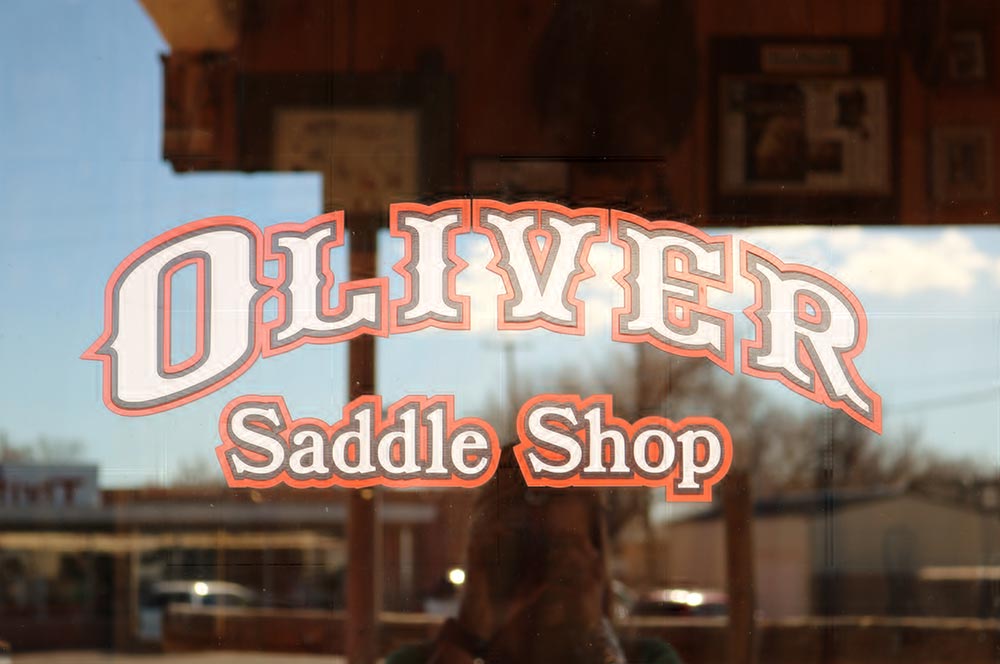
CONTACTS
Oliver Saddle Shop
3016 Plains Blvd.
Amarillo, TX 79102
1-806-372-7562
richard@oliversaddle.com
www.oliversaddle.com
QUOTES
"We can fine tune the saddle. If you buy a ready-made, you get what’s there. When you come in to see us, you can sit in that seat and we trim the seat, until it fits.” — Richard Oliver, owner, Oliver Saddle Shop
“When I show people around the shop, they see that this is not an assembly line. Each craftsman builds a saddle from start to finish, one at a time.” — Bryan Oliver, Oliver Saddle Shop
“What is most popular with us is the rough-side-out saddle. These saddles go through a lot in the brush and sun and all kinds of weather. If you scratch it — so what!” — Richard Oliver, owner, Oliver Saddle Shop
This article is originally published on www.shoptalk-magazine.com and re-published here with permission.
Photos courtesy Adams Ranch - Joe Adams; Rancher Joe Adams, of Adams Ranch, a roughly 12,000-acre, cow-calf operation set between Tulia and Silverton, Texas, knows what he wants in a good working saddle.
Photos courtesy of Oliver Saddle Shop
There are more interesting articles in our section on Tack & Farm.






